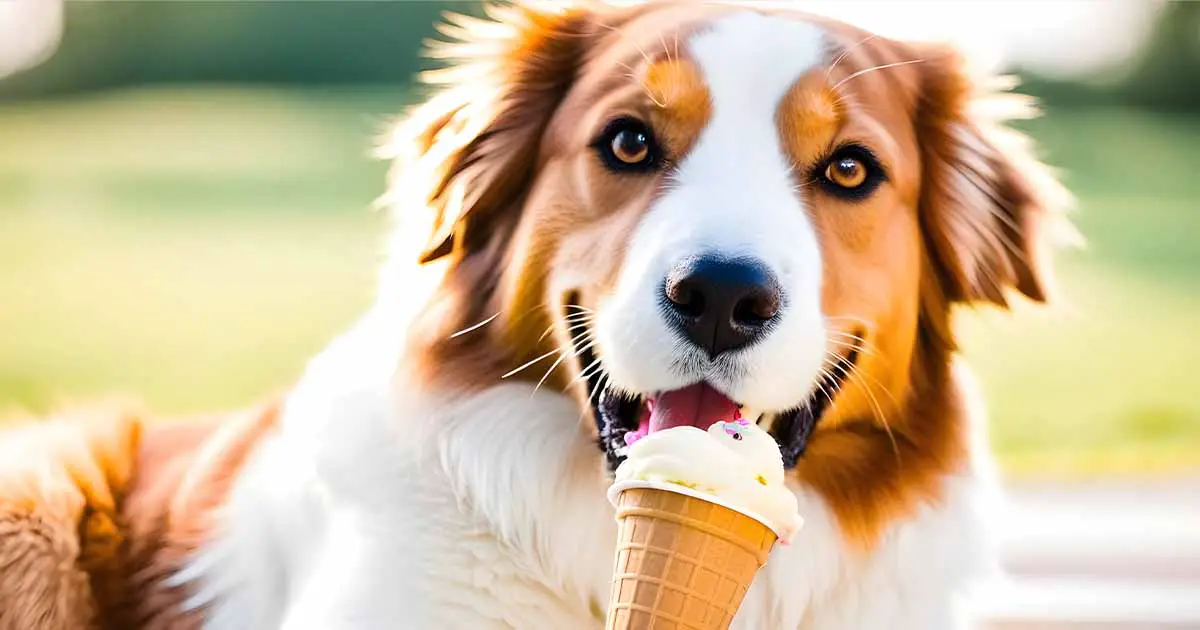When it comes to treating our furry friends, it’s tempting to share our favorite snacks with them. One popular question among dog owners is, “Can dogs eat ice cream?” While the idea of indulging your canine companion with a creamy, cold treat may seem delightful, there are some important factors to consider before offering them a scoop. Let’s explore into the sweet world of ice cream and know whether it’s a safe and suitable treat for our four-legged friends.
The Dairy Dilemma:
Lactose Intolerance in Dogs:
Dogs, like some humans, can be lactose intolerant. Lactose is a sugar found in milk and dairy products, and many dogs lack the enzyme needed to break it down. Feeding ice cream to a lactose-intolerant dog can lead to digestive issues such as stomach upset, diarrhea, and abdominal discomfort.
Opt for Lactose-Free Options:
If your pup is a fan of ice cream, consider choosing lactose-free alternatives. Several pet-friendly ice creams are available on the market, specifically formulated to cater to canine taste buds without causing digestive distress. These options ensure a safer indulgence for your furry friend.
The Sugar Conundrum:
Excessive Sugar and Dogs:
While your dog may have a sweet tooth, too much sugar can be detrimental to their health. Obesity, dental problems, and even diabetes can result from a diet high in sugar. Traditional ice cream is often loaded with sugar, making it a less-than-ideal choice for dogs.
Make Your Own Dog-Friendly Ice Cream:

For a healthier alternative, consider making homemade dog-friendly ice cream. Use ingredients like plain yogurt, peanut butter, and banana to create a tasty and safe frozen treat for your pup. This way, you can control the ingredients and tailor the ice cream to your dog’s preferences.
3. Yogurt Parfait Delight:
Yogurt is a canine-friendly dairy option that can be transformed into a tasty and nutritious frozen treat. Layer plain, unsweetened yogurt with dog-safe fruits like blueberries or strawberries in a cup or mold. Freeze the concoction, and voila – a yogurt parfait delight that’s not only pleasing to the palate but also beneficial for your dog’s digestive health.
4. Watermelon Wedges:
During hot summer days, watermelon can be a hydrating and delicious alternative to traditional ice cream. Remove the seeds and offer your dog small, frozen watermelon wedges. The high water content is excellent for hydration, and the natural sweetness makes it a refreshing treat.
5. Coconut Bliss Bites:
Coconut oil is a fantastic addition to your dog’s diet, offering various health benefits. Create coconut bliss bites by mixing coconut oil with dog-friendly ingredients like shredded carrots or apples. Freeze the mixture in bite-sized portions for a tropical and wholesome indulgence.
There’s no need to deny your dog the joy of a frozen treat when there are plenty of healthy alternatives available. Whether it’s the potassium-packed frozen banana bites, protein-rich peanut butter popsicles, or the refreshing watermelon wedges, these alternatives not only cater to your dog’s cravings but also contribute to their overall well-being. Experiment with these recipes to find the perfect icy delight that your furry friend will wag their tail for – a treat that’s as healthy as it is tasty.
Ingredients:
- Plain, unsweetened yogurt
- Dog-safe fruits (e.g., blueberries, strawberries, or watermelon)
Instructions:
- Mix yogurt with chopped dog-friendly fruits.
- Spoon the mixture into ice cube trays or silicone molds.
- Freeze until solid.
These frosty fruit pops not only provide a burst of flavor but also deliver essential nutrients for your dog’s well-being.
2. Paw-some Peanut Butter Cups:
Ingredients:
- Natural, unsalted peanut butter
- Banana slices
Instructions:
- Spread a thin layer of peanut butter on the bottom of a silicone mold.
- Place a banana slice on top of the peanut butter.
- Cover with another layer of peanut butter.
- Freeze until firm.
These peanut butter cups are a delightful combination of creamy and crunchy, sure to please your pup’s palate.
3. Icy Tuna Treats:
Ingredients:
- Canned tuna in water (drained)
- Low-sodium chicken broth
Instructions:
- Mix tuna with low-sodium chicken broth.
- Pour the mixture into ice cube trays.
- Freeze until solid.
Perfect for dogs who love a savory treat, these icy tuna treats offer a protein-packed solution to beat the heat.
4. Coconut Chill Delight:
Ingredients:
- Coconut water
- Shredded coconut (unsweetened)
Instructions:
- Mix coconut water with shredded coconut.
- Pour the mixture into ice cube trays or molds.
- Freeze until solid.
The coconut chill delight not only provides a tropical twist but also introduces the benefits of coconut water to your dog’s diet.
No, dogs should not eat coffee ice cream or any ice cream containing caffeine. While many dogs are known to enjoy the occasional taste of plain vanilla ice cream in small amounts, coffee-flavored ice cream poses additional risks due to the presence of caffeine. Here are the reasons why coffee ice cream is not suitable for dogs:
1. Caffeine Sensitivity:
- Caffeine Content: Coffee ice cream contains caffeine, which is harmful to dogs. Caffeine can negatively affect a dog’s central nervous system, leading to restlessness, increased heart rate, and, in severe cases, even caffeine toxicity.
2. Toxicity Concerns:
- Symptoms of Caffeine Toxicity: Ingesting caffeine can lead to symptoms such as hyperactivity, elevated heart rate, tremors, vomiting, diarrhea, and, in extreme cases, seizures or death. Dogs are more sensitive to caffeine than humans, and even small amounts can be dangerous.
3. Avoidance of Artificial Additives:
- Additional Ingredients: Coffee ice cream may contain artificial additives, flavorings, or sweeteners that are not suitable for canine consumption. Xylitol, a common sweetener in sugar-free products, is particularly dangerous for dogs.
It’s important to note that caffeine can be present in various products, including coffee-flavored foods, medications, and energy drinks. Therefore, it’s not only the traditional sources like coffee that pose a risk.
If you suspect your dog has ingested a product containing caffeine, it is crucial to seek immediate veterinary attention. Even small amounts of caffeine can have serious consequences for dogs, and professional intervention is the best course of action to ensure their safety and well-being. If in doubt, consult with your veterinarian for guidance tailored to your dog’s specific situation.
If you discover that your dog has ingested coffee ice cream, which contains caffeine, it’s essential to take immediate action. Caffeine is toxic to dogs, and prompt intervention is crucial to minimize the potential risks. Here’s a step-by-step guide on what to do if your dog has eaten coffee ice cream:
1. Assess the Situation:
- If you catch your dog in the act or find evidence that they’ve consumed coffee ice cream, assess the situation promptly. Note any symptoms they may be exhibiting and try to determine the quantity ingested.
2. Contact Your Veterinarian:
- Emergency Call: Immediately contact your veterinarian or the nearest emergency veterinary clinic. Provide details about the situation, including the type of ice cream, the amount ingested, and any observed symptoms.
3. Do Not Induce Vomiting Without Professional Guidance:
- Vomiting Risks: In the case of caffeine ingestion, inducing vomiting is not always recommended and can pose additional risks. It’s crucial to seek guidance from your veterinarian before attempting to induce vomiting.
4. Follow Veterinarian Recommendations:
- Expert Advice: Your veterinarian will provide guidance based on the severity of the situation. They may instruct you to monitor your dog for symptoms or recommend immediate veterinary care, depending on the amount of caffeine ingested.
When it comes to your dog’s diet, it’s crucial to be aware of various ingredients that can be harmful or even toxic to them. Here’s a list of other ingredients to avoid, as they can pose health risks to your canine companion:
1. Xylitol:
- A sugar substitute often found in sugar-free gum, candies, and baked goods. Xylitol can cause a rapid release of insulin, leading to hypoglycemia (low blood sugar), seizures, and liver failure in dogs.
2. Grapes and Raisins:
- Grapes and raisins can cause kidney failure in dogs. Even small amounts can be toxic, leading to symptoms such as vomiting, diarrhea, lethargy, and abdominal pain.
3. Onions and Garlic:
- Onions and garlic, whether raw, cooked, or in powdered form, contain compounds that can damage a dog’s red blood cells, leading to anemia. Avoid feeding your dog foods seasoned with onion or garlic.
4. Chocolate:
- Chocolate contains theobromine, a stimulant that can be toxic to dogs. Dark chocolate and baking chocolate have higher theobromine levels and pose a greater risk. Ingesting chocolate can lead to symptoms ranging from restlessness to seizures.
5. Alcohol:
- Alcohol, even in small amounts, can be dangerous for dogs. It can cause intoxication, depression of the central nervous system, and even lead to coma or death. Keep all alcoholic beverages out of reach.
6. Avocado:
- Avocado contains a substance called persin, which, in large amounts, can be toxic to dogs. While the flesh itself is generally safe in small quantities, avoid giving dogs avocado pits and skin.
7. Bones:
- Cooked bones, especially poultry bones, can splinter and cause gastrointestinal blockages or perforations. Stick to giving your dog specially designed and vet-approved chew toys.
8. Caffeine:
- As discussed earlier, caffeine is present in coffee, tea, and some sodas. It can lead to restlessness, increased heart rate, tremors, and, in severe cases, caffeine toxicity.
9. Macadamia Nuts:
- Macadamia nuts can cause weakness, vomiting, tremors, and hyperthermia in dogs. Even a small amount of macadamia nuts can result in adverse effects.
10. Certain Medications:
- Some human medications, such as pain relievers (ibuprofen, acetaminophen), antidepressants, and certain cold medications, can be toxic to dogs. Always keep medications out of reach and consult your vet before giving any over-the-counter drugs to your dog.
Conclusion:
Related content:
Can you steep coffee like tea?





